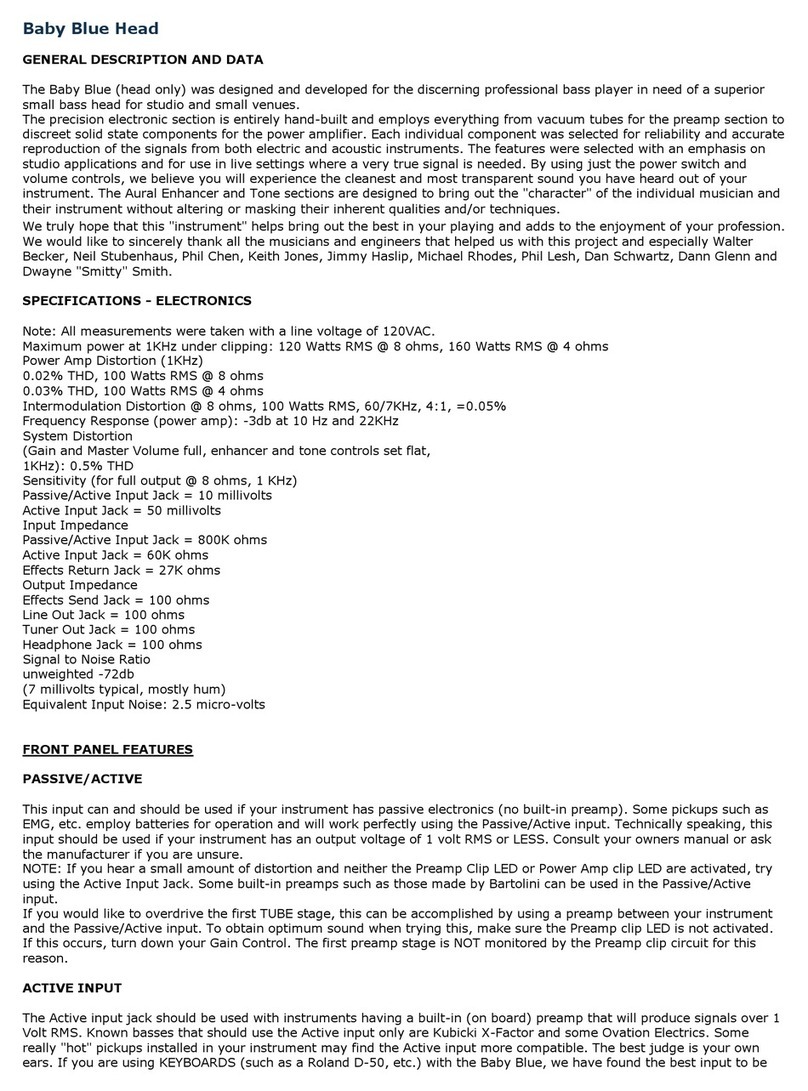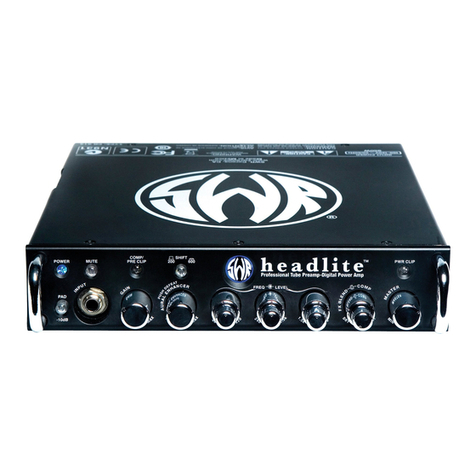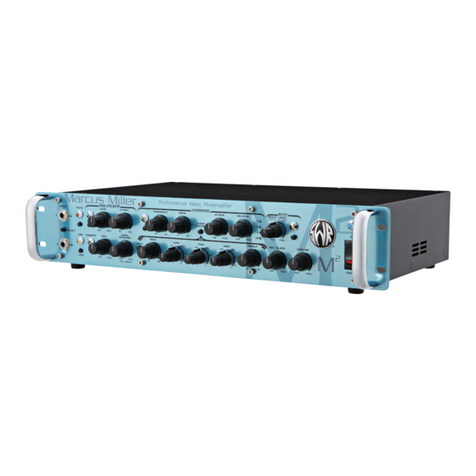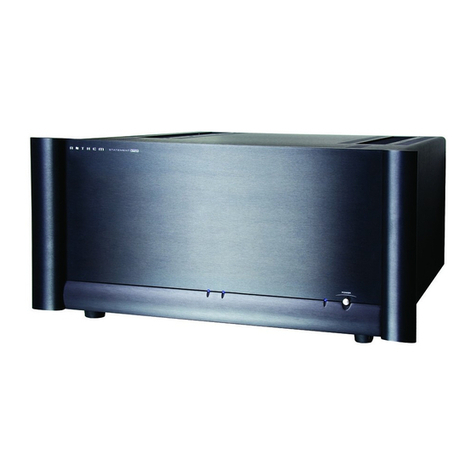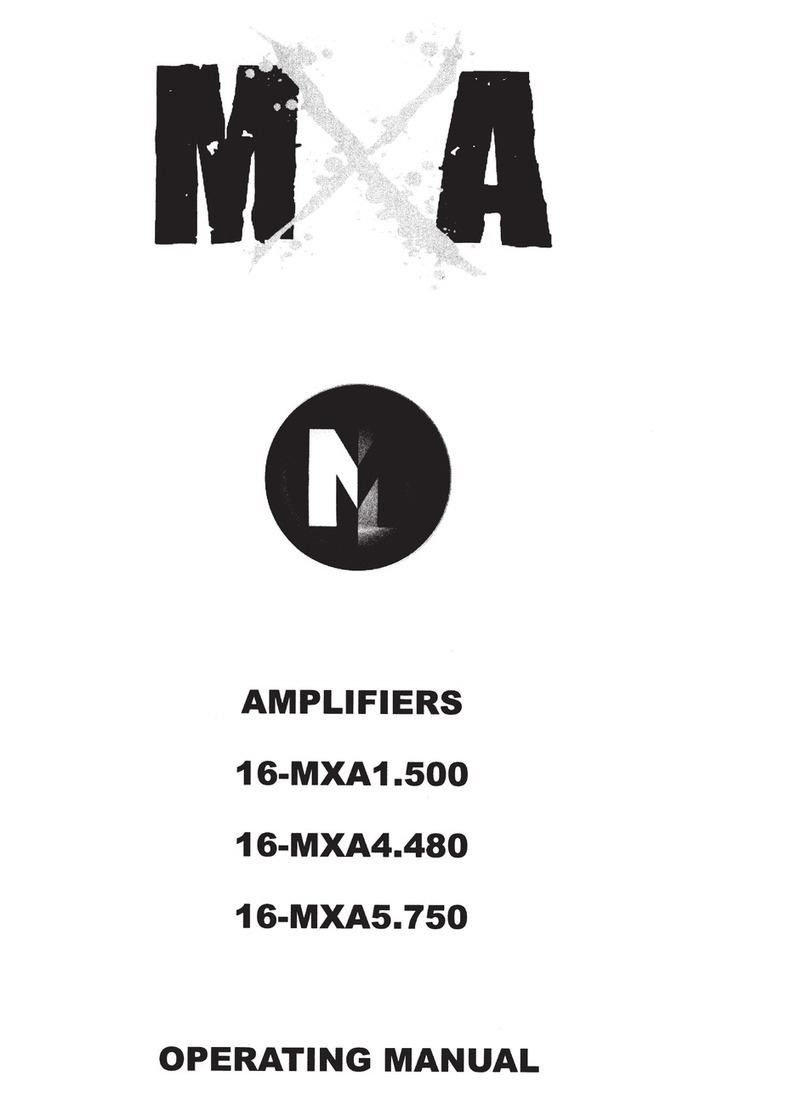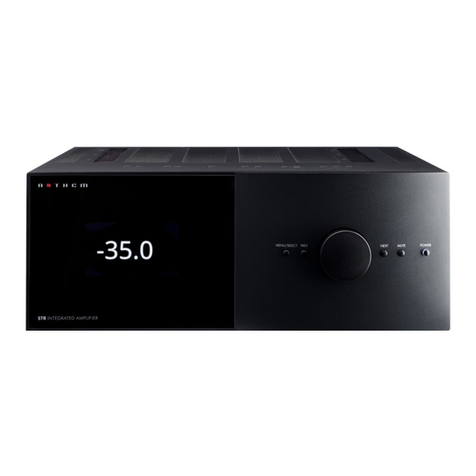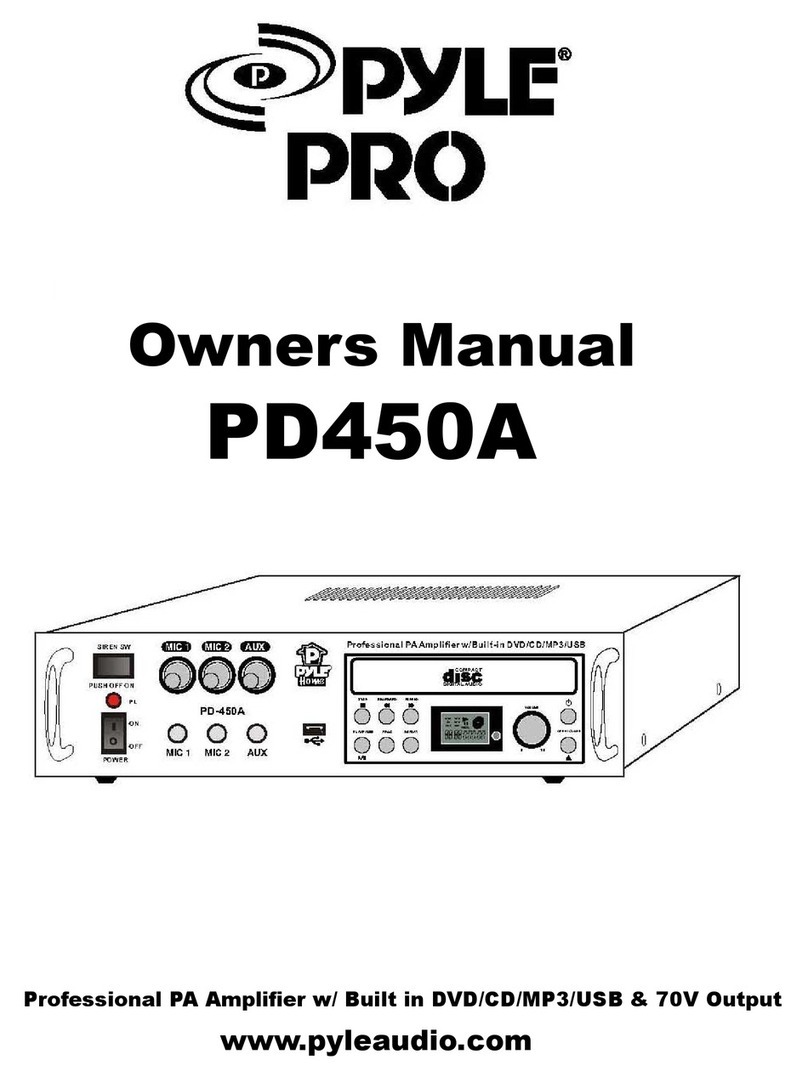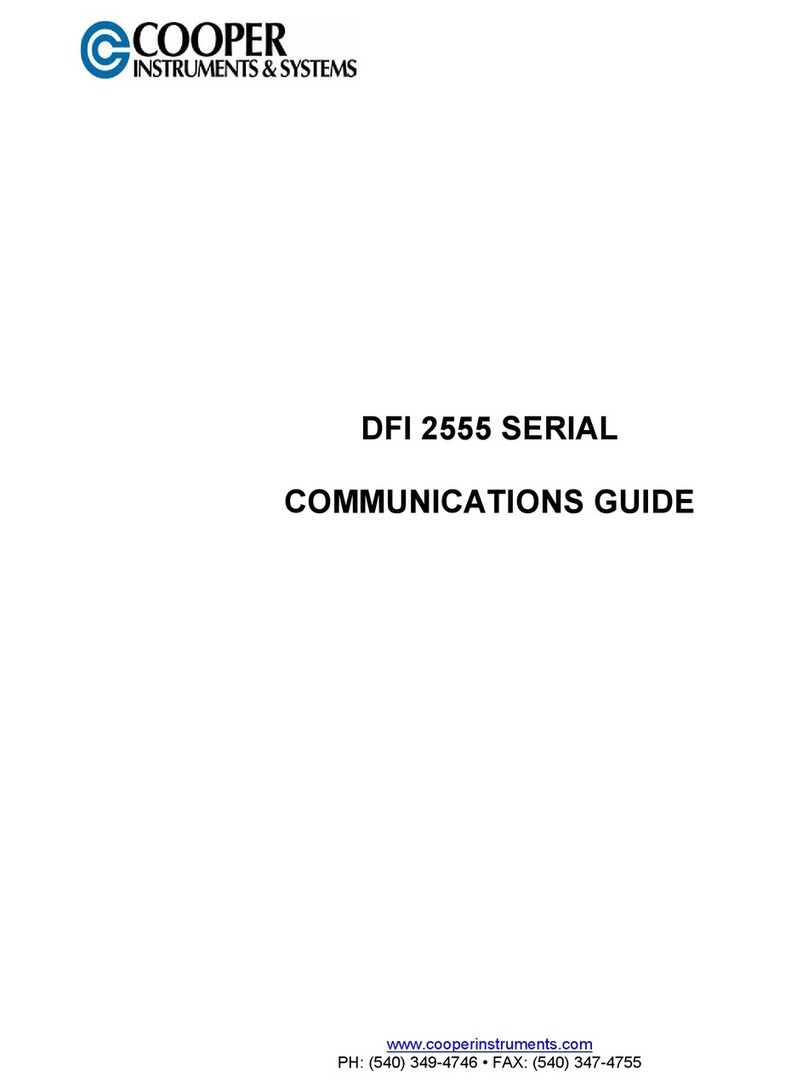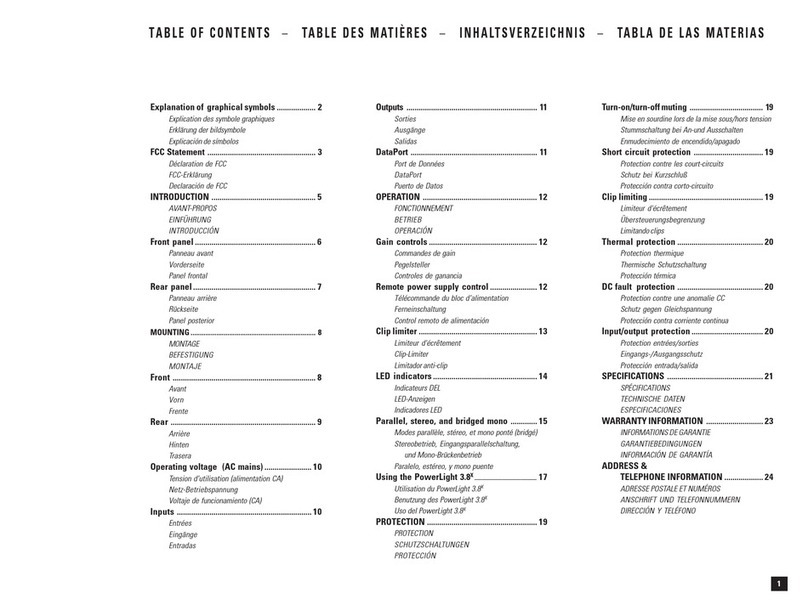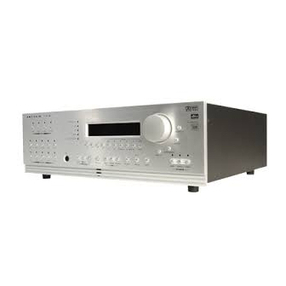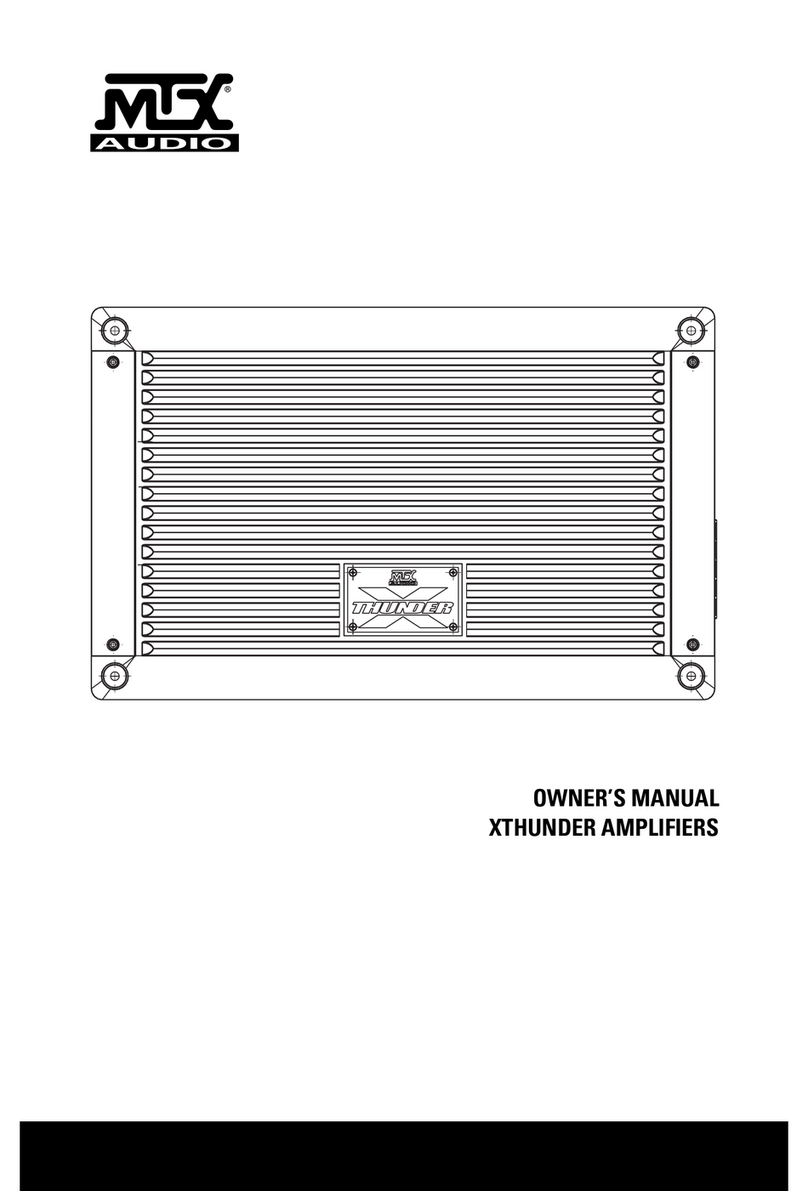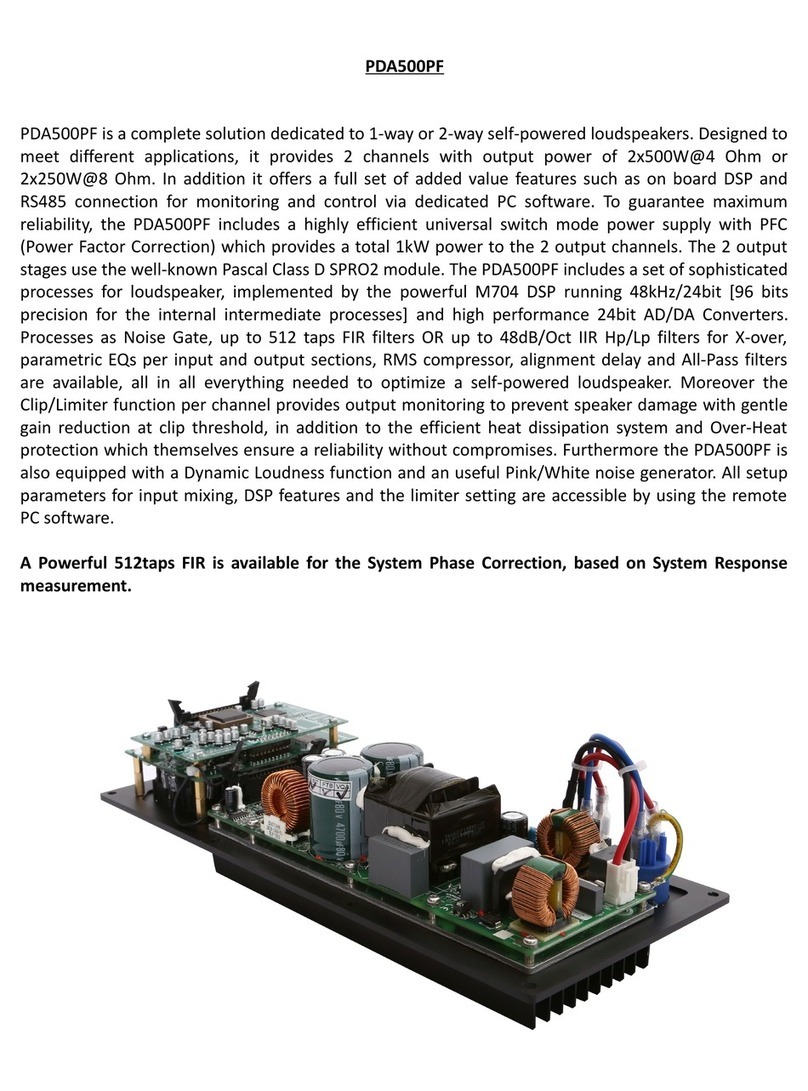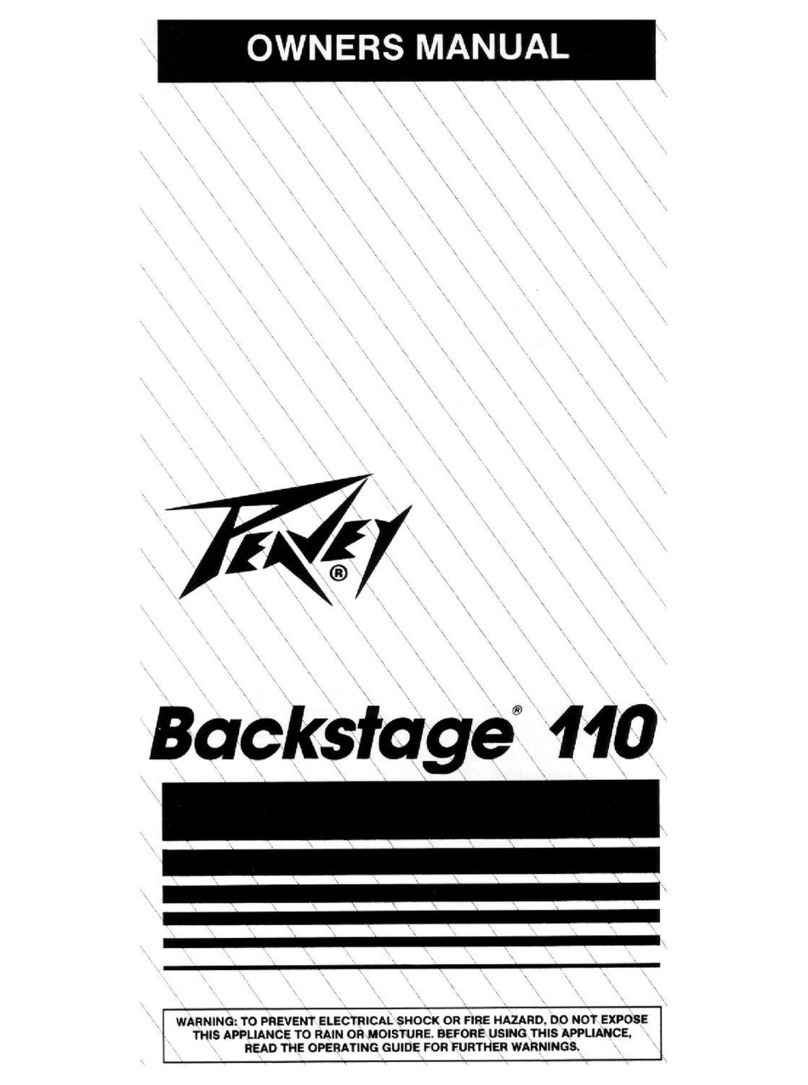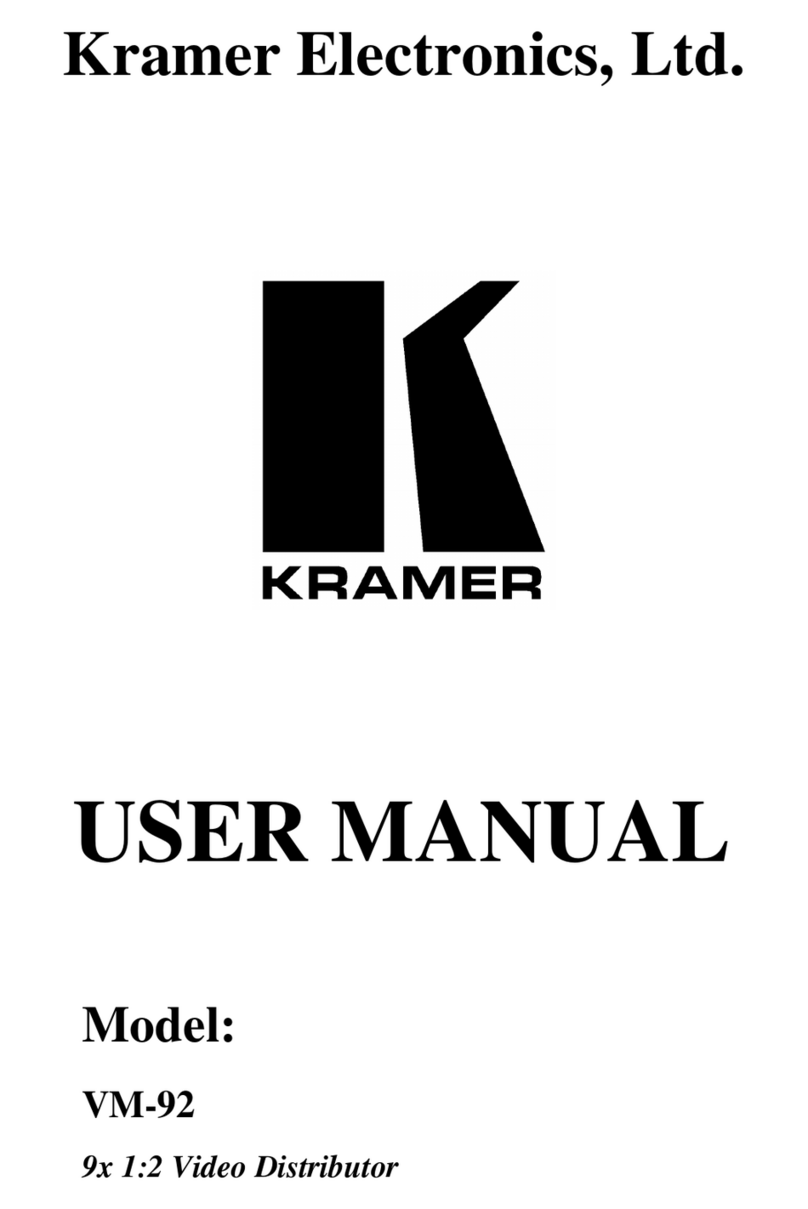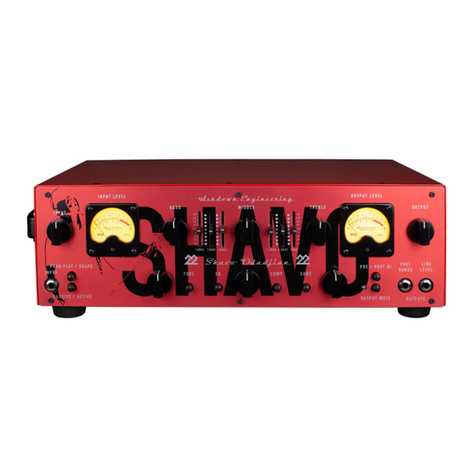SWR Spellbinder Blue User manual

SPELLBINDER BLUE™
(This is the model name for warranty claims)
Fender Musical Instruments Corporation, 8860 East Chaparral Road Suite 100 Scottsdale, AZ 85250
Issued: July, 2008
p/n 4420500010 (120V)
SERVICE MANUAL
ATTENTION:
WARRANTY SERVICE PROCEDURES
Service of the Digital Power Amp Module and Ancillary Power Supply contained in
the SWR Spellbinder Blue is to be accomplished by module replacement only.
The Class D Power Amp Module outputs a PWM Signal. You can not evaluate the output waveform
without a specially designed filter. Please note: that if the speaker ground should contact
chassis or preamp ground it will instantly destroy the Power Amp Module. Use caution
when connecting test equipment to the speaker ground as it could result in a connection to
Earth Ground and destruction of the Power Amp Module. Ground must be lifted on any test
equipment used in troubleshooting the Power Amp Module.

SPELLBINDER BLUE™
(This is the model name for warranty claims)
2
September 2008
IMPORTANT NOTICE
•Copyright © 2008 FMIC. All rights reserved. All
information contained herein is CONFIDENTIAL
and PROPRIETARY and is the property of
Fender® Musical Instruments Corporation. It is
not to be sold or assigned to another party and is
disclosed solely for use by Fender Authorized
Service Centers for purposes of product service
and maintenance. All information is not to be dis-
closed to others without the expressed permission
of Fender® Musical Instruments Corporation. All
specifications are subject to change without no-
tice. This information and any copies produced
electronically or otherwise must be surrendered
upon demand of Fender® Musical Instruments
Corporation.
•Parts marked with two asterisks (**) indicate the
required use of that specific part. This is neces-
sary for RELIABILITY and SAFETY requirements.
DO NOT USE A SUBSTITUTE!
PARTS LIST CODES
The description codes used in the itemized Parts Lists are defined below:
CAPACITOR CODES
CAP AE = Aluminum Electrolytic
CAP CA = Ceramic Axial
CAP CD = Ceramic Disk
CAP CR = Ceramic Radial
CAP MPF = Metalized Polyester Film
CAP MY = Mylar
CAP PFF = Polyester Film/Foil
RESISTOR CODES
RES CC = Carbon Comp
RES CF = Carbon Film
RES FP = Flame Proof
RES MF = Metal Film
RES MOX = Metal Oxide
RES WW = Wire Wound
HARDWARE CODES
BLX = Black Oxide
CR = Chrome Plated
HWH = Hex Washer Head
M = Machine Screw
NI = Nickel Plated
OHP = Oval Head Phillips
PB = Particle Board
PHP = Pan Head Phillips
PHPS = Pan Head Phillips Sems
SMA = Sheet Metal "A" Point
SMB = Sheet Metal "B" Point
SS = Stainless Steel
TF = Thread Forming
ZI = Zinc Plated

SPELLBINDER BLUE™
(This is the model name for warranty claims)
3
SPECIFICATIONS
Model Name: SPELLBINDER BLUE
Release Number: PR 761
Part Numbers (120V, 60 z) US: 4420500010
(240V, 50 z) AUS: 4420503010
(230V, 50 z) UK: 4420504010
(230V, 50 z) EUR: 4420506010
(100V, 50 z) JPN: 4420507010
Power Requirement: 575 W
Power Output: 160W RMS into 4Ω @ <1 THD
Power Amp Sensitivity: 9mV (1/4”) 900µV (XLR) for 160W into 4Ω
Impedances Input (Pre-Amp): 4.7MΩ (1/4”) 20kΩ (XLR)
Effects Send: 1kΩ
Effects Receive: 10kΩ
Speaker Complement: Eminence Neodymium 4Ω, 10” (P/N 0076017000)
Eminence Super-Tweeter 8Ω (P/N 0067254000)
Dimensions eight: 19.62 in (49.8 cm)
Width: 15.38 in (39.0 cm)
Depth: 14.5 in (36.8 cm)
Weight: 26.5 lbs (11.6 kg)
Product specifications are subject to change without notice

SPELLBINDER BLUE™
(This is the model name for warranty claims)
4
SERVICE NOTES
1. CHASSIS REMOVAL is accomplished by re-
moving the four (4) screws from the top of the
cabinet that secure the chassis. Pull the chas-
sis out toward the rear about 4” (10cm) and
disconnect the two speaker cable connectors
from the speaker On/Off switch (white wire) and
Speakon®jack PCB (black wire).
2. PREAMP PCB REMOVAL is accomplished by
removing the nuts, washers, and screws that
secure the PCB to the chassis front panel, and
one chassis standoff screw near the power
switch. Care must be taken to ensure that the
removed PCB is insulated from any exposed
metal or other hardware when power is applied.
3. REAR PANEL PCB REMOVAL is accom-
plished by removing the nuts, washers, and
screws that secure the PCB to the chassis rear
panel. There is enough cabling to remove the
PCB and place it in front of the chassis. Care
must be taken to ensure that the removed PCB
is insulated from any exposed metal or other
hardware when power is applied.
4. 160W POWER AMP MODULE, ANCILLARY
POWER SUPPLY, & TUBE PCB REMOVAL is
accomplished by removing the chassis standoff
screws. The cables to these boards are not
long enough to allow their removal and opera-
tion out of the chassis.
5. XOVER PCB REMOVAL is accomplished by
removing the front grille (4 screws), 10” speaker
(4 screws), then removing the XOVER PLATE
located inside the cabinet (4 screws). It’s ok to
touch the white insulation with your bare hands.

SPELLBINDER BLUE™
(This is the model name for warranty claims)
5
PCB EXCHANGE POLICY
Parts marked with a single asterisk (*) in the Part
Lists are not field replaceable. If a failure due to
one of these components is detected, please con-
tact the FMIC Customer Service Department to
order the complete PCB Assembly.
CIRCUIT DESCRIPTION
This section provides concise information about new
or unusual circuitry designs incorporated into this
amplifier model. The purpose is to aid the service
technician by providing insight into the design areas
most likely to become obstacles in troubleshooting.
Information is focused for its effective use while
maintaining the security of Fender® proprietary in-
formation wherever possible.
Preamp PCB:
The following discussion follows the signal path
through the functional blocks of the amplifier. The
signal is introduced at J8-A (XLR) or J8-B (¼”). The
XLR input will see a 20kΩinput impedance while
the ¼” input will see a 4.7MΩinput impedance. U6A
provides a gain of 10 for the XLR input while the ¼”
input goes directly into the tube gain stage of V1-A.
The GAIN stage at U7A provides up to 1.1X gain,
followed by the PHASE reversal stage at U5A. This
allows the phase of the channel to be changed 180°
depending on the position of S3.
The EQ IN/OUT Switch (S6) selects either the pas-
sive Aural Enhancer circuit (the classic circuit found
in other SWR bass amplifiers) or the active attenua-
tion of U5B. The signal then goes to the second
tube stage at V1-B.
Following the tube buffer at U13A is the EQ circuitry
comprising U9A&B, U10A and U13B. This architec-
ture is similar to the SWR Baby Baby Blue amplifier,
and boosts or attenuates each frequency range by
+/-15dB. The frequency response of this stage is
flat when all of the level knobs are at their center-
detent position.
S6-D selects the post-EQ path from U13B or the
pre-EQ path from U13A. From here the signal goes
to the Effects Send buffer at U11A, the EFFECTS
BYPASS switch (S7), and also to the EFFECTS
BLEND pot (R91) which blends the Send and Re-
turn signal before U10B, which contains a -12dB/
octave high-pass filter.
U8B is the Compressor chip which works with U15A
to reduce the signal at this point when the COM-
PRESSION pot (R92) is turned clockwise. U8 pin
16 is a current driven pin. The circuitry for this cur-
rent is produced by U14A&B, U15B, and U16A&B.
The maximum amount of compression available is
approximately 20dB.
The MASTER Volume control (R93) is at U12A
which has a maximum gain of 3.5X. This stage and
the inverted signal at U12B serve as a gain buffer
for the power amp at P6.4 and P6.7.
The Preamp Clip Detect circuits operate simply by
monitoring several stages of the preamp. If any of
the sense points rise above the overload threshold
(approximately 12V), the Clip LED will be illumi-
nated.
The MUTE circuitry is engaged using S8. The
Speaker mute circuitry is on the Power Amp PCB
while the Balanced Line Output mute circuitry is on
the Rear Panel PCB.
Rear Panel PCB:
The Rear Panel PCB is a breakaway from the Pre-
amp PCB and is connected to the Preamp PCB
through a 12 circuit ribbon cable assembly (P7 on
the Preamp, P1 on the Rear Panel). The signals

SPELLBINDER BLUE™
(This is the model name for warranty claims)
6
are: TUNER_RP, EFX_RTN-, EFX_RTN+,
LINE_RP, MUTE_RP, HEADPHONE, EFX_SEND+,
and EFX_SEND-. There is also +/-15V as well as
analog ground.
TUNER_RP feeds both the tuner output buffer at
U1B as well as the DIRECT signal for the BAL-
ANCED LINE OUTPUTS. The DIRECT or LINE_RP
signal is selected using S1, and is muted by FETs
Q1 and Q2. The signal is then buffered at U1A,
where the PAD control (R4) sets the output level. A
balanced line driver DRV134 (U2) is employed to
produce a high quality signal at both the balanced
¼” (J3) and XLR jack (J7).
The HEADPHONE output (J5) employs a paralleled
pair of 4560 opamps to obtain high current drive
capability for all types of headphones.
XOVER PCB:
The speaker crossover components are located on
the XOVER PCB, inside the speaker cabinet. L1 is
a -6dB/octave low-pass filter for the 10” speaker
and C3 is a -6dB/octave high-pass filter for the
Horn. A 50W L-PAD (connected to the PCB via
wires) controls the volume of the Horn.
160W Power Amp:
The power amp assembly is the Bang & Olufsen
50ASX2. This is a complete power supply and 160
Watt amplifier on a single PCB Assembly. The
power amplifier is produced and tested independ-
ently, and is a non-serviceable part.
The amplifier output connects to the Internal
Speaker On/Off switch and Speakon jack via the
twisted pair black and white wires, which are termi-
nated with insulated faston receptacles. The
Speaker Output ground can not, must not, ever
connect to Preamp ground or chassis ground.
Doing this will immediately destroy the power
amp module. Be careful when connecting test
equipment (such as oscilloscopes) to the
speaker output ground, as this can result in a
connection to Earth ground.
The power amp module also produces a low volt-
age +/-25V supply at P103. This low voltage supply
is made available to the Ancillary Power Supply
(Fender p/n 0076036000), which in turn produces
the other voltages needed by the Preamp circuits.
See the Ancillary Power Supply section for more
information.
Ancillary Power
Supply:
The Ancillary Power Supply is a non-serviceable
switching power supply module that takes the +/-
25V AUX Supply output from the B&O 50ASX2 and
creates the following voltages: +300V (Tube), 12.6V
(Tube Heater), and +/-15V (Preamp Op amps). The
module must be loaded to get the correct voltages
out of it, so do not operate it with the 6 pin header
unconnected.

SPELLBINDER BLUE™
(This is the model name for warranty claims)
*Non-serviceable part. Replace complete parent assembly. See PCB EXCHANGE POLICY section above.
shaded Unique Fender® part. Order directly from the FMIC Parts Department.
shaded + * Access to this part or assembly is controlled. Please contact the FMIC Customer Service Department.
** Safety Requirement part. Replacement must match Safety Agency…–Value, if specified –Type, if specified –Approval Mark(s) if on part.
shaded + ** Both a unique Fender® part and a Safety Requirement part as defined above.
7
.PARTS LIST:
PREAMP – PCB ASSEMBLY
QTY. PART # DESCRIPTION REFERENCE DESIGNATION
9 0028463003 CAP AE RDL 10uF 50V 20% C31-32 C38 C40 C43 C49 C81 C96 C99
3 0028474003 CAP AE RDL 100uF 25V 20% C87 C93-94
1 0028459003 CAP AE RDL 2.2uF 50V 20% C80
10 0028467003 CAP AE RDL 22uF 50V 20% C2 C10-11 C20 C35-36 C44 C54 C86 C88
1 0028460003 CAP AE RDL 4.7uF 50V 20% C46
1 0028471003 CAP AE RDL 47uF 50V 20% C33
8 0051457003 CAP CD 100pF 500V 5% C8 C13 C55 C60-61 C67 C69 C91
4 0051405003 CAP CD 120pF 500V 5% C37 C42 C71 C77
3 0051445003 CAP CD 22pF 500V 5% C12 C45 C66
11 0051406003 CAP CD 220pF 500V 10% C4-5 C14-15 C17-18 C21 C23 C25 C68 C89
2 0051407003 CAP CD 390pF 500V 10% C50 C65
1 0051408003 CAP CD 47pF 500V 5% C41
2 0051458003 CAP CD 470pF 500V 10% C28 C30
1 0051409003 CAP CD 68pF 500V 5% C95
18 0034788003 CAP CR .1uF 50V 20% .2" LS C6 C9 C16 C19 C24 C29 C34 C39 C47-48
C72-74 C76 C79 C82 C85 C101
1 0066051000 CAP MPF AX 3.3uF 250V 10% C3
1 0027255003 CAP MPF .001uF 100V 10% C52
7 0027264003 CAP MPF .01uF 100V 10% C7 C22 C58 C78 C90 C92 C98
1 0027278003 CAP MPF .1uF 63V 10% C56
1 0027281003 CAP MPF .22uF 63V 10% C64
1 0027283003 CAP MPF .33uF 63V 10% C57
1 0027261003 CAP MPF .0047uF 100V 10% C62
6 0027272003 CAP MPF .047uF 63V 10% C53 C59 C63 C83-84 C100
1 0027286003 CAP MPF .47uF 63V 10% C51
1 0027263003 CAP MPF .0082uF 100V 10% C75
1 0024823000 CAP MPF RDL .01uF 400V 10% C1
2 0024845000 CAP MPF RDL .047uF 400V 10% C26-27
1 0030936003 CAP PFF RDL .0022uF 50V 5% C70
1 0048488003 CAP PFF RDL .22uF 50V 5% C97
3 0076660000 CONTROL HORZ DUAL CONC 1M15C 50k1B R3 R23 R42
2 0064621000 CONTROL VERT 50k B TAPER R89 R92
1 0076659000 CONTROL VERT 10k B TAPER R91
2 0073613000 CONTROL VERT 50k 30C R4 R93
1 0072481000 CNTRL VERT 24mm 500k 10A R87
4 0064089001 DIODE 1N4003 D1-2 D4-5
25 0006260001 DIODE 1N4448 SIGNAL D3 D6-8 D10-16 D20 D22 D25-29 D31 D34-39
1 0031635001 DIODE ZEN 1N5240B 10V 5% LL D40
2 0076792001 DIODE ZEN 1N5230B 4.7V 5% LL D17-18
1 0027327001 DIODE ZEN 1N5234B 6.2V 5% LL D30
9 0025802000 FSTN TAB MALE .250x.032 PCB MT P3-5 P8 P11-14 P17
2 0072485000 HDR .1 CTR 6 CKT SQ PIN LONG P9-10

SPELLBINDER BLUE™
(This is the model name for warranty claims)
*Non-serviceable part. Replace complete parent assembly. See PCB EXCHANGE POLICY section above.
shaded Unique Fender® part. Order directly from the FMIC Parts Department.
shaded + * Access to this part or assembly is controlled. Please contact the FMIC Customer Service Department.
** Safety Requirement part. Replacement must match Safety Agency…–Value, if specified –Type, if specified –Approval Mark(s) if on part.
shaded + ** Both a unique Fender® part and a Safety Requirement part as defined above.
8
.PARTS LIST:
PREAMP – PCB ASSEMBLY
QTY. PART # DESCRIPTION REFERENCE DESIGNATION
2 0027419000 HDR .1 CTR 10 CKT SQ PIN P2 P15
2 0027421000 HDR .1 CTR 12 CKT SQ PIN P1 P7
1 0027413000 HDR .1 CTR 6 CKT SQ PIN P16
1 0076663000 HDR 2MM CTR 7 CKT SQ PIN P6
4 0031611000 IC OP-AMP DUAL PC4560 U3-4 U6 U11
1 0072486000 IC BAL LINE DRIVER DRV134 U2
1 0069312000 IC OTA DUAL LM13700N U8
11 0016795000 IC OP-AMP DUAL TL072 U1 U5 U7 U9-10 U12-17
1 0076661000 INDUCTOR AIR CORE RDL 220uH L1
1 0063756000 JACK SPEAKON 4-POLE PCB HOR MNT J4
2 0030987000 JACK 1/4 PCB 3/CD DOC J3 J5
2 0066432000 JACK 1/4 PCB STEREO W/TS J1 J6
1 0073421000 JACK 1/4 PCB 3/CD DCC INS J2
1 0073245000 JACK NEUTRIK COMBO XLR & 1/4" STEREO J8
1 0066471000 LED BLUE #480010 D9
1 0064404000 LED HIGH EFFECIENCY GREEN T-1 3mm
CLEAR D32
4 0064511000 LED HIGH EFFECIENCY RED T-1 3mm
CLEAR D19 D21 D24 D33
1 0070997000 LED YELLOW T1 LONG LEAD D23
2 0025116001 RES CF 1/2W 5% 100k LL R28 R31
2 0024952001 RES CF 1/4W 5% 100ohm LL R79 R123
10 0024965001 RES CF 1/4W 5% 1k LL R2 R6-7 R10 R12 R30 R44 R71 R127 R162
25 0024981001 RES CF 1/4W 5% 10k LL
R15 R17 R39 R43 R47 R49-50 R52 R54 R56
R59 R65 R77 R95 R102 R105-107 R110 R118
R122 R126 R150 R154 R166
24 0024997001 RES CF 1/4W 5% 100k LL
R13-14 R18 R24-26 R36-37 R45 R60 R66 R78
R81-82 R84 R86 R90 R98 R103 R108 R128
R144 R155 R169
7 0025069001 RES CF 1/4W 5% 1M LL R62 R69 R75 R131 R161 R165 R167
1 0025084001 RES CF 1/4W 5% 10M LL R170
2 0029002001 RES CF 1/4W 5% 11k LL R85 R111
4 0024969001 RES CF 1/4W 5% 1.5k LL R16 R68 R76 R117
1 0024999001 RES CF 1/4W 5% 150k LL R120
1 0025073001 RES CF 1/4W 5% 1.5M LL R121
2 0024970001 RES CF 1/4W 5% 1.8k LL R73 R104
1 0024986001 RES CF 1/4W 5% 18k LL R83
2 0029005001 RES CF 1/4W 5% 2k LL R67 R109
1 0024971001 RES CF 1/4W 5% 2.2k LL R129
8 0024987001 RES CF 1/4W 5% 22k LL R9 R21 R88 R132 R135 R137 R151 R168
3 0025059001 RES CF 1/4W 5% 220k LL R29 R139 R152
5 0024973001 RES CF 1/4W 5% 3.3k LL R116 R124 R148 R156 R163
6 0024989001 RES CF 1/4W 5% 33k LL R74 R96 R112 R145 R153 R160
1 0025077001 RES CF 1/4W 5% 3.3M LL R22

SPELLBINDER BLUE™
(This is the model name for warranty claims)
*Non-serviceable part. Replace complete parent assembly. See PCB EXCHANGE POLICY section above.
shaded Unique Fender® part. Order directly from the FMIC Parts Department.
shaded + * Access to this part or assembly is controlled. Please contact the FMIC Customer Service Department.
** Safety Requirement part. Replacement must match Safety Agency…–Value, if specified –Type, if specified –Approval Mark(s) if on part.
shaded + ** Both a unique Fender® part and a Safety Requirement part as defined above.
9
.PARTS LIST:
PREAMP – PCB ASSEMBLY
QTY. PART # DESCRIPTION REFERENCE DESIGNATION
1 0024991001 RES CF 1/4W 5% 39k LL R147
1 0028956001 RES CF 1/4W 5% 43k LL R97
10 0024947001 RES CF 1/4W 5% 47ohm LL R8 R19 R32-35 R40 R53 R57 R61
2 0024961001 RES CF 1/4W 5% 470ohm LL R63 R171
3 0024977001 RES CF 1/4W 5% 4.7k LL R38 R41 R58
4 0024993001 RES CF 1/4W 5% 47k LL R80 R130 R136 R143
2 0025065001 RES CF 1/4W 5% 470k LL R64 R70
2 0025079001 RES CF 1/4W 5% 4.7M LL R55 R114
1 0024994001 RES CF 1/4W 5% 56k LL R94
4 0024995001 RES CF 1/4W 5% 68k LL R72 R115 R125 R172
1 0024980001 RES CF 1/4W 5% 8.2k LL R113
10 0015582001 RES MF 1/4W 1% 10.0k LL R1 R11 R20 R27 R99-100 R134 R140 R146
R164
4 0031819001 RES MF 1/4W 1% 1.82k LL R46 R48 R158-159
2 0031818001 RES MF 1/4W 1% 18.2k LL R51 R101
4 0025816001 RES MF 1/4W 1% 20.0k LL R119 R133 R141 R149
2 0016944001 RES MF 1/4W 1% 562ohm LL R142 R157
2 0016960001 RES MF 1/4W 1% 5.62k LL R138 R173
1 0055750000 RES WW BT 10W 10% 2.7ohm R5
2 0072483000 SOCKET .1 CTR 6 CKT RA PS1-2
1 0056312000 SOCKET TUBE 9 PIN W/COLLAR PCB XV1
7 0050817000 SWITCH PB PC VERT MNT DPDT S1-5 S7-8
1 0050816000 SWITCH PB PC VERT MNT 4P2T S6
1 0049892000 XLR CONNECTOR MALE GOLD J7
2 0016739003 XSTR NPN 2N4401 TO-92 Q3-4
2 0016742003 XSTR PNP 2N4403 TO-92 Q5-6
2 0041465003 XSTR N-CH JFET J113 TO-92 Q1-2
8 0065384000 EXTENSION BUTTON 2.8mm SHAFT @ switches
8 0070524000 BUTTON SWITCH ROUND BLACK @ switches
7 0065470000 SPACER LED VERTICAL .1"x .935" @ LEDs
PARTS LIST:
ANCILLARY POWER SUPPLY – PCB ASSEMBLY
QTY. PART # DESCRIPTION REFERENCE DESIGNATION
6 REF *CAP AE RDL 22uF 100V 20% 105C C8 C13-14 C19 C22-23
2 REF *CAP AE RDL 47uF 350V 20% 85C C24-25
1 REF *CAP CD 100pF 500V 5% C9
1 REF *CAP CA 3300pF 100V C6
1 REF *CAP CD 220pF 500V 10% C7
2 REF *CAP MPF .01uF 100V 10% C3-4
2 REF *CAP MPF RDL .1uF 250V 10% C17-18
13 REF *CAP SF .1uF 100V 10% C1-2 C5 C10-12 C15 C20-21 C27-30

SPELLBINDER BLUE™
(This is the model name for warranty claims)
*Non-serviceable part. Replace complete parent assembly. See PCB EXCHANGE POLICY section above.
shaded Unique Fender® part. Order directly from the FMIC Parts Department.
shaded + * Access to this part or assembly is controlled. Please contact the FMIC Customer Service Department.
** Safety Requirement part. Replacement must match Safety Agency…–Value, if specified –Type, if specified –Approval Mark(s) if on part.
shaded + ** Both a unique Fender® part and a Safety Requirement part as defined above.
10
PARTS LIST:
ANCILLARY POWER SUPPLY – PCB ASSEMBLY
QTY. PART # DESCRIPTION REFERENCE DESIGNATION
2 REF *DIODE 1N4448 SIGNAL D3 D5
1 REF *DIODE SCHOTTKY 100V 3.3A 31DQ10 D7
2 REF *DIODE SCHOTTKY BAT85 D1 D4
4 REF *DIODE HV FDH400 SWITCHING LL D10-13
13 REF *DIODE SB1H100 1A D6 D14-25
1 REF *DIODE ZEN 1N5245B 1/2W 15V 5% LL Z1
1 REF *HDR .1 CTR 6 CKT SQ PIN P2
1 REF *HDR 2MM CTR 3 CKT SQ PIN P1
1 REF *IC DIP DUAL FLIP-FLOP CD4027BCN U1
1 REF *IC DIP-14 INVERTER CD4069UBC U2
1 REF *IC I-MODE PWM CONTROLLER UC3843 DIP 8 U3
1 REF *INDUCTOR ANCILLARY P.S. T1
1 REF *RES CF 1/4W 5% 2.2k LL R4
1 REF *RES CF 1/4W 5% 27k LL R2
1 REF *RES CF 1/4W 5% 470ohm LL R10
1 REF *RES CF 1/4W 5% 4.7k LL R9
1 REF *RES CF 1/2W 5% 8.2k LL R5
1 REF *RES CF 1/2W 5% 1M LL R14
1 REF *RES CF 1/2W 5% 5.6ohm LL R8
1 REF *RES MF 1/4W 1% 1.00k LL R12
1 REF *RES MF 1/4W 1% 48.7k LL R1
1 REF *RES MF 1/4W 1% 4.75k LL R11
1 REF *RES MF 1/4W 1% 1.37k LL R7
1 REF *RES MF 1/4W 1% 8.25k LL R3
1 REF *RES FILM 1W .47ohm 5% R13
1 REF *RES FILM 1W 390ohm 5% LL R6
2 REF *RES FILM 1W 680ohm 5% R15-16
1 REF *XFMR ANCILLARY P.S. MOSFET DRIVER T2
1 REF *XFMR ANCILLARY P.S. TUBE PWR T3
1 REF *XFMR ANCILLARY P.S. +/-15V T4
2 REF *XSTR NPN 2N4401 TO-92 Q4 Q11
1 REF *XSTR PNP 2SA1038STPS Q2
1 REF *XSTR PNP 2SB1236 Q5
1 REF *XSTR NPN 2SD1857 Q1
5 REF *XSTR POWER MOSFET IRF530NLPbF Q6-10
1 REF *XSTR NPN MPSW42 TO-226AE Q3
4 REF *STANDOFF NYL PCB SNAP 3/8
1 REF *SUPPORT TO-220 STANCHION PAD (Q6)

SPELLBINDER BLUE™
(This is the model name for warranty claims)
*Non-serviceable part. Replace complete parent assembly. See PCB EXCHANGE POLICY section above.
shaded Unique Fender® part. Order directly from the FMIC Parts Department.
shaded + * Access to this part or assembly is controlled. Please contact the FMIC Customer Service Department.
** Safety Requirement part. Replacement must match Safety Agency…–Value, if specified –Type, if specified –Approval Mark(s) if on part.
shaded + ** Both a unique Fender® part and a Safety Requirement part as defined above.
11
PARTS LIST:
CHASSIS ASSEMBLY
QTY. PART # DESCRIPTION REFERENCE DESIGNATION
1 0076030000 * PWR AMP MOD ICEpower 50ASX2 BTL BRIDGED
1 0076018000 * PANEL CHASSIS FRONT SPELLBINDER BLUE
1 0076019000 * PANEL CHASSIS REAR SPELLBINDER BLUE
1 0076032000 * PCB ASSY PREAMP SPELLBINDER BLUE
1 0076036000 * PCB ASSY POWER SUPPLY ANCILLARY 15/HV
6 0064836000 SCRW M 6-32x1/4 PHP ZI SEMS @ PCB MOUNTS
1 0031188000 SCRW M 4-40x1/4 PHP ZI ITLW @ ANCILLARY POWER SUPPLY
6 0051155000 SCRW SMB 4x3/8 PHP BLX @ XLR & SPEAKON JACKS
1 0038900000 SCRW TF 6-32X1/4 PHP ZI @ IEC GND LUG
7 0025936000 STANDOFF NYL PCB SNAP 3/8 AUX Supply, Tube & Speaker Out PCB
7 0028937000 SCRW TF 6-32x5/8 PHP ZI SELL 049 AUX Supply, Tube & Speaker Out PCB
4 0051404000 STANDOFF NYLON BLK .375 @ IEC PCB
2 0041602000 SCRW M 6-32x3/8 FHP BLX sell 049 @ IEC CONNECTOR
1 0073513000 CABLE RIBBON ASSY 12 CKT 16" PREAMP TO REAR PANEL
1 0056588000 CABLE RIBBON ASSY 10 CKT 6" PREAMP TO TUBE PCB
1 0076503000 CABLE VH 3-CKT 2-COND 10" POWER AMP TO IEC PCB
1 0076012000 CABLE ASSY VH 2-CKT 2-COND 6" POWER AMP TO SPKR OUT PCB
1 0076504000 CABLE B&O ANCILLARY POWER SUPPLY
POWER AMP TO ANCILLARY
POWER SUPPLY
1 0056586000 CABLE RIBBON ASSY 6 CKT 6" ANC. POWER SUPPLY TO PREAMP
1 0076505000 CABLE RIBBON VH 7-CKT 10" POWER AMP TO PREAMP
1 0047213000 ** CONNECTOR AC LINE MALE IEC
1 0065927000 BADGE SWR HUBCAP MINI
2 0067098000 SPEED NUT PUSH ON TYPE SMALL
1 0068325000 ** SWITCH ROCKER SPST 16A EURO POWER SWITCH
1 0076035000 SWITCH ROCKER SPDT 16A INTERNAL SPEAKER ON/OFF SWITCH
1 0067248000 TUBE 12AX7-A PRE-SELECTED V1
1 0023598000 TUBE SHIELD (099-0723-000)
3 0066460000 KNOB DUAL CON INNER #DR110-006
3 0066461000 KNOB DL-CON OTR #TPP151-008-90
3 0066454000 KNOB CAP BLK W/WHT LINE #C111
6 0066459000 KNOB CONE-SHAPED W/WHT LINE sell 049
PARTS LIST:
CHASSIS ASSEMBLY
QTY. PART # DESCRIPTION REFERENCE DESIGNATION
1 0076029000 **XFMR B&O 160W AMP 100V 50Hz JAPAN MODEL ONLY
2 0022004000 NUT KEPS #8-32 ZINC sell 049 JAPAN MODEL ONLY
@ TRANSFORMER MOUNT
2 0016473000 SCRW M 8-32x1/2 PHP ZI JAPAN MODEL ONLY
@ TRANSFORMER MOUNT

SPELLBINDER BLUE™
(This is the model name for warranty claims)
*Non-serviceable part. Replace complete parent assembly. See PCB EXCHANGE POLICY section above.
shaded Unique Fender® part. Order directly from the FMIC Parts Department.
shaded + * Access to this part or assembly is controlled. Please contact the FMIC Customer Service Department.
** Safety Requirement part. Replacement must match Safety Agency…–Value, if specified –Type, if specified –Approval Mark(s) if on part.
shaded + ** Both a unique Fender® part and a Safety Requirement part as defined above.
12
PARTS LIST:
CABINET ASSEMBLY
QTY. PART # DESCRIPTION REFERENCE DESIGNATION
1 0070639000 HANDLE RUBBER CONTOUR @ TOP
8 0021972000 NUT T 10-32x3/4 STR 3 PRNG BLX @ SPEAKERS & TOP HANDLE
AR 0064107000 CARPET BLUE TWEED
1 0070629000 CORNER PLASTIC 100DEG LEFT SIDE
1 0070630000 CORNER PLASTIC 100DEG RIGHT SIDE
4 0070452000 CORNER PLASTIC CHEVRON BEVEL EDGE
24 0016627000 SCRW SMA 8x3/4 OHP BLX @ PLASTIC CORNERS
4 0048471000 SCRW M 10-32x1 OHP STL BLX @ TOP HANDLE
4 0033380000 SCRW SMAB 8x1 THP BLX @ FEET
12 0026576000 SCRW SMA 8x5/8 THP BLK SELL 049 @ TILT-BACK FOOT
6 0017439000 SCRW SMA 6x1/2 PHP BLX @ VENT
1 0067259000 VENT BABY BABY BLUE
4 0048976000 FOOT RUBBER 1-1/2" BXR 115 @ BOTTOM
1 0070640000 FOOT CABINET TILT-BACK @ BOTTOM
PARTS LIST:
END ITEM ASSEMBLY
QTY. PART # DESCRIPTION REFERENCE DESIGNATION
1 0076011000 *CABINET ASSY SPELLBINDER BLUE
1 0076027000 *GRILLE CHROME SPELLBINDER BLUE
1 0076017000 SPKR 10" 4 OHM EMINENCE NEO
1 0067254000 TWEETER NEW CAL. BLONDE
1 0076028000 *PLATE ASSY XOVER SPELLBINDER BLUE
4 0065940000 BLACK STOPPER GRILLE MOUNT GRILLE MOUNT
4 0067025000 SMS #8X1-1/2 PH TRUSS S/STEEL GRILLE MOUNT
4 0054264000 SCRW SMAB 8x3-4 THP BLX HORN MOUNT
4 0026577000 SCRW M 10-32x1 PHP BLX 10” SPEAKER MOUNT
4 0036199000 SCRW M 8-32x1-3/16 OHP BLX CP sell 049 CHASSIS MOUNT
4 0029527000 WSHR FNSH 8-5/8 FLNGD BLX WX CHASSIS MOUNT
4 0026576000 SCRW SMA 8x5/8 THP BLK XOVER PLATE MOUNT
0053997000 ** CORD PWR W/IEC CONN 100V
1 0047248000 ** CORD PWR W/IEC CONN DOM
0047249000 ** CORD PWR W/IEC CONN 230V UK
0047250000 ** CORD PWR W/IEC CONN 250V
0047251000 ** CORD PWR W/IEC CONN 230V
PARTS LIST:
XOVER PLATE ASSEMBLY
QTY. PART # DESCRIPTION REFERENCE DESIGNATION
1 0076013000 PLATE XOVER SPELLBINDER BLUE
1 0066495000 LPAD 8 OHM 50W #AT-50H - L-8 OHM

SPELLBINDER BLUE™
(This is the model name for warranty claims)
*Non-serviceable part. Replace complete parent assembly. See PCB EXCHANGE POLICY section above.
shaded Unique Fender® part. Order directly from the FMIC Parts Department.
shaded + * Access to this part or assembly is controlled. Please contact the FMIC Customer Service Department.
** Safety Requirement part. Replacement must match Safety Agency…–Value, if specified –Type, if specified –Approval Mark(s) if on part.
shaded + ** Both a unique Fender® part and a Safety Requirement part as defined above.
13
PARTS LIST:
XOVER PLATE ASSEMBLY
QTY. PART # DESCRIPTION REFERENCE DESIGNATION
1 0064463000 KNOB PLASTIC W/POINTER, XOVER
4 0073612000 STNDOFF HX M/F AL 6-32x1-1/4
1 0029894000 WSHR LCK INTL 3/8x .500x .022 NI @ LPAD
1 0016352000 NUT HEX 3/8-32x3/32 TK NI( sell 049) @ LPAD
4 0031184000 SCRW M 6-32x1/4 PHP BLX ITLW @ STANDOFFS

SPELLBINDER BLUE™
(This is the model name for warranty claims)
14
Service Diagram List
Service Diagram (Schematic) ............PREAMP PCB
Service Diagram (PCB Assembly) ............PREAMP PCB
Chassis Assembly ............SPELLBINDER BLUE
End Item Assembly ............SPELLBINDER BLUE
Wire Set (PCB Assembly) ….. ............SPELLBINDER BLUE
Wire Set (Chassis Assembly) ….........SPELLBINDER BLUE






Other manuals for Spellbinder Blue
1
Table of contents
Other SWR Amplifier manuals
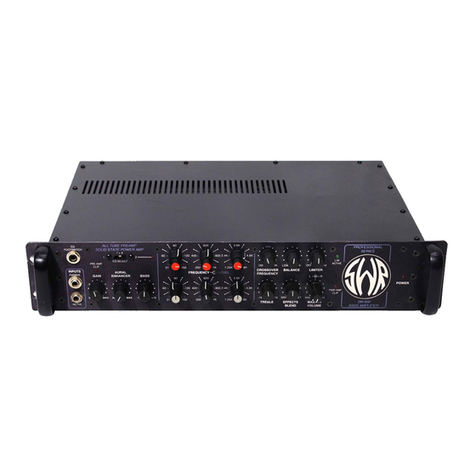
SWR
SWR SM-900 User manual

SWR
SWR Strawberry Blonde II User manual
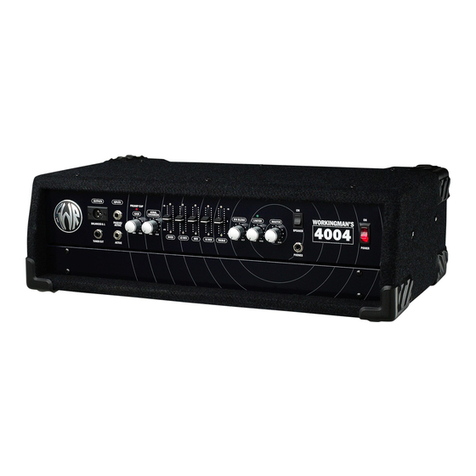
SWR
SWR WORKINGMAN'S 4004 User manual
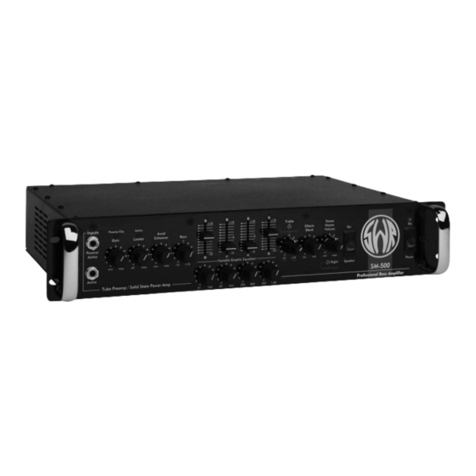
SWR
SWR SM-500 User manual
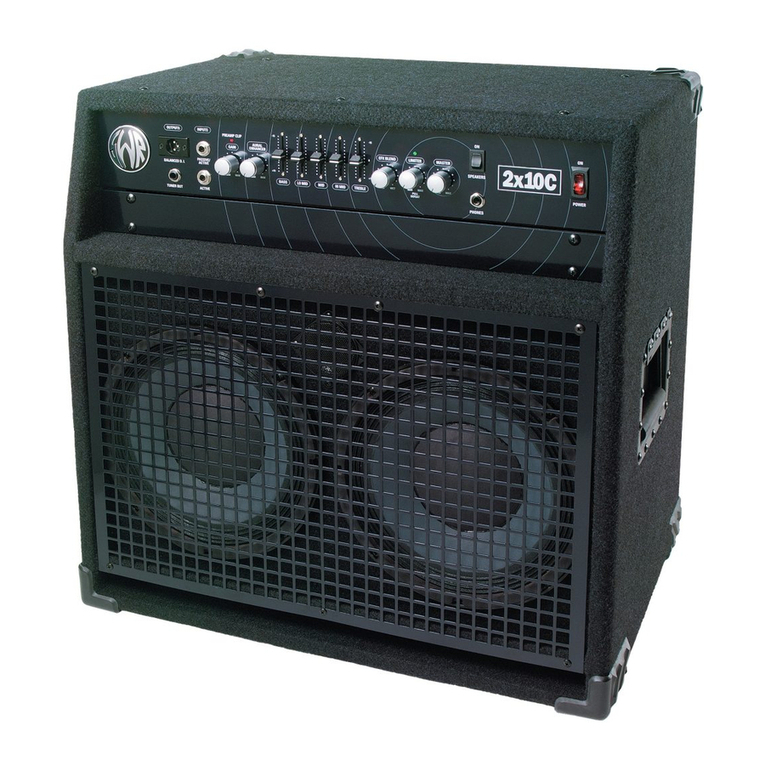
SWR
SWR WorkingPro 2x10C User manual
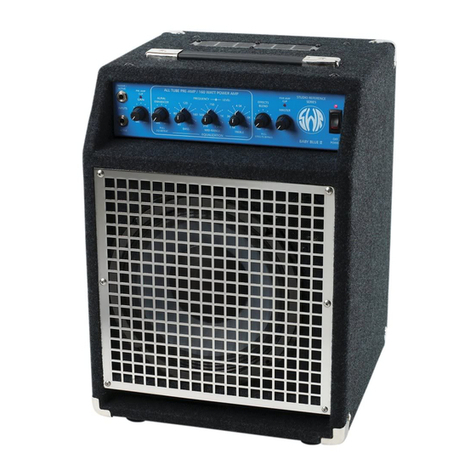
SWR
SWR Baby Baby Blue User manual
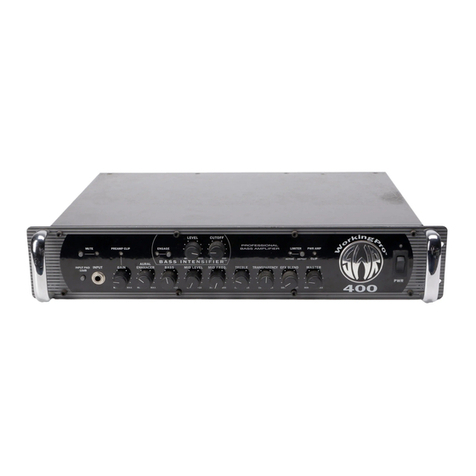
SWR
SWR WorkingPro Series User manual
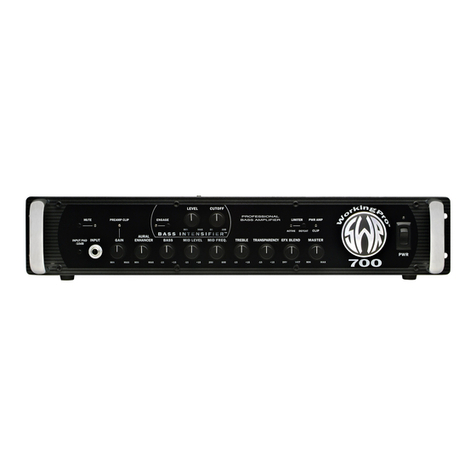
SWR
SWR WorkingPro WorkingPro 700 User manual
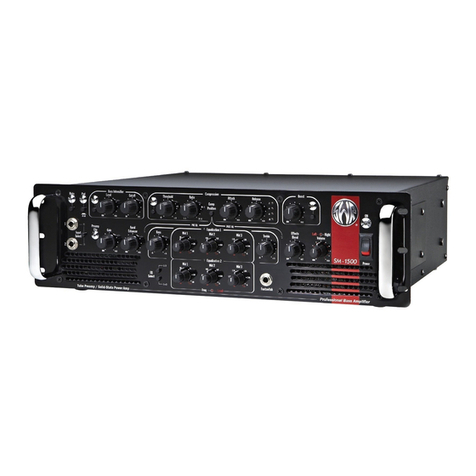
SWR
SWR SM-1500 User manual
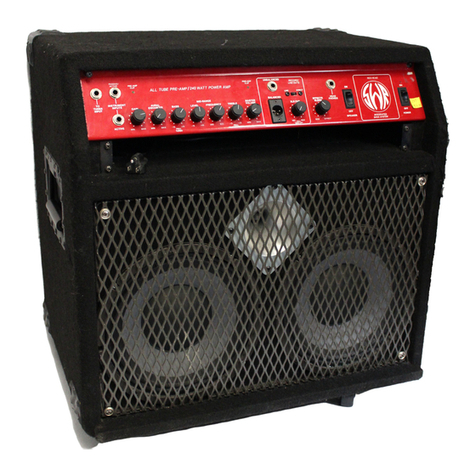
SWR
SWR Super Redhead User manual

SWR
SWR California Blonde User manual
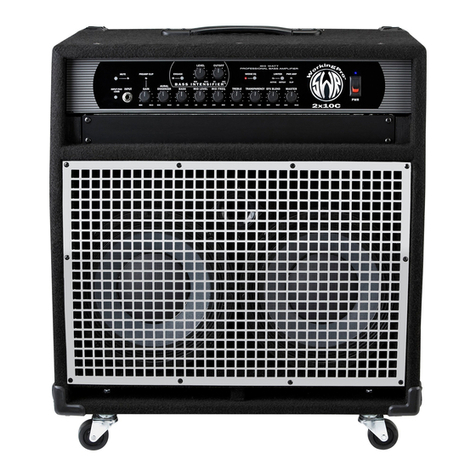
SWR
SWR WorkingPro 2x10C User manual

SWR
SWR Workingman's 8004 O User manual

SWR
SWR Baby Blue II User manual
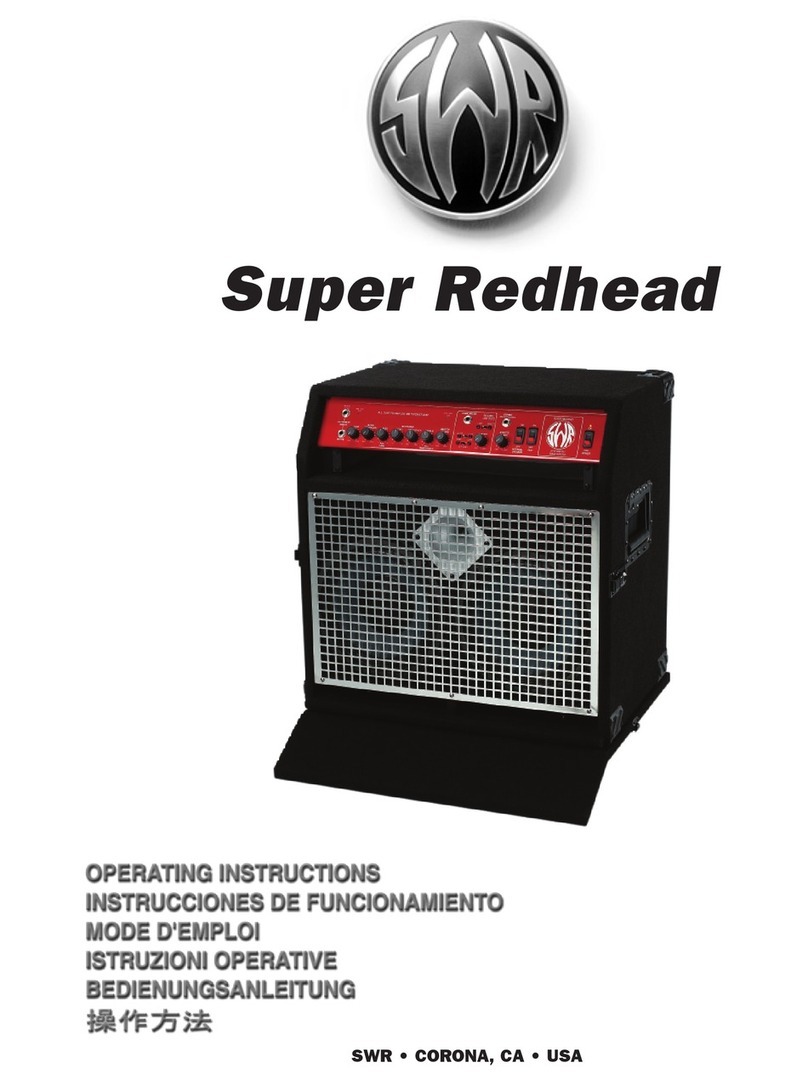
SWR
SWR Super Redhead User manual

SWR
SWR Strawberry Blonde User manual
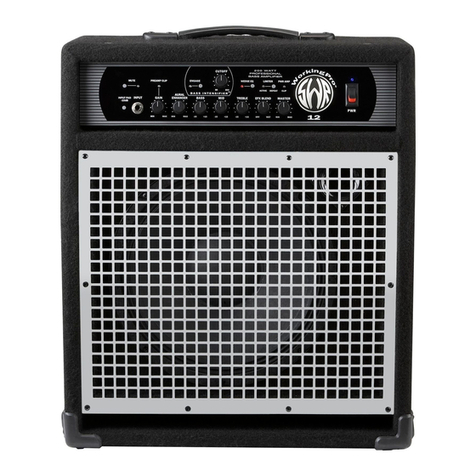
SWR
SWR WorkingPro 12 User manual
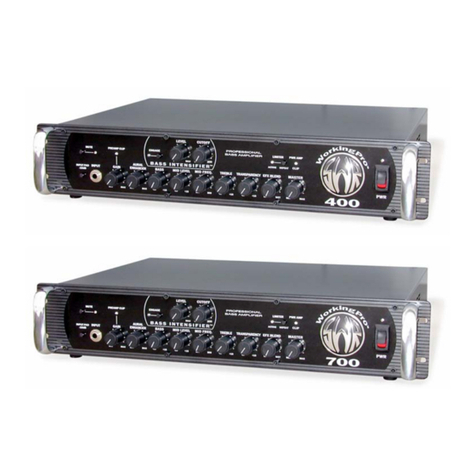
SWR
SWR WorkingPro 400 User manual
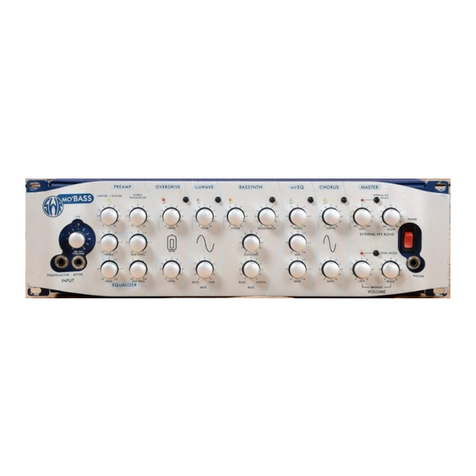
SWR
SWR Mo' Bass User manual

SWR
SWR WORKINGMAN'S 2004 User manual
